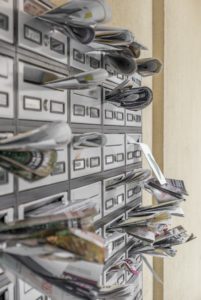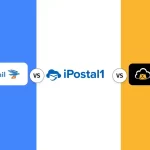Say goodbye to unwanted mail for good with these proven methods to stop junk mail from flooding your mailbox. Get started today!

Inside: Junk mail defined (per Seinfeld) Why people still want mail What is junk mail, really? Getting a physical address in the US What’s the cost of junk mail? Remove your name from mailing lists Opt out of credit card offers Contact the credit bureau Contract offending companies Dispose of your junk mail the old-fashioned way Use a virtual mailbox For citizens of the world Additional tips
When it comes to junk mail, everyone has an opinion. Remember Newman, Jerry’s neighbor and mailman on the hit show Seinfeld? Much like everything else about his character, Newman’s opinion on junk mail was anything but subtle.
“There really is no junk mail. Everybody wants to get a check or a birthday card, but they require just as much manpower to deliver as their precious little greeting cards!” Newman exclaims on Seinfeld in Season 8.
His timeless point: one person’s trash is another’s treasure. Some folks pine for their weekly grocery coupon mailer and will probably lament its eventual demise. Some people living on a fixed income depend on the mail to deliver their social security or pension checks. Still others want the human contact of the mailman or mailwoman handing them their letters.
Then there are those of us, concerned environmental types mostly, who fly off the handle when the free neighborhood newspapers start stacking up on the porch. Instead of seeing kindling for my bonfire, I imagine the old growth forest going under the chainsaw for its intrinsic resources, which are priceless…for printing coupons.
Whether you have a temporary mailing address, a P.O. box, an apartment mailing address, or a relative retrieving your mail, we share the same common affliction. If you have a physical address in these United States of America, you receive upwards of 300 pieces of junk mail every year!
Of course, junk mail is more than coupons.
It’s a category that applies to quite a few items you would rather not receive, including the unsolicited credit card offers that can get plucked from your trash and used to steal your identity. Let’s not forget about the free local business phone books as ubiquitously distributed as the yellow pages of medieval times and about as useful. Or what about the plethora of two-inch thick catalogs so prolific they could have been sourced from the mighty sequoias themselves? Or the endless political fundraising during silly season, which now starts a year-and-a-half before election day!? And that doesn’t even include the volume of mail sent your way by the advertisers themselves, hawking products directly to your mailbox.
It all adds up to about one third of the mail you receive every day. Or presented another way: you, personally, receive 41 pounds of junk mail every year.
What’s the cost of Junk Mail?
To advertisers in the states, the cost of printing junk mail exceeds $46 billion annually.
To mother nature, that equals 100 MILLION trees per year, ballpark.
This is one of those good news, bad news situations. Bad news first: even if you follow every tip and trick in the environmental handbook, inevitably, some junk mail will slip through the filter and, as time passes, that filter will become a crack, then – bam! – you’ve got a mailbox full of circulars and kitty litter samples again. The good news is that all of the tips recommended here can put an end to your junk mail troubles.
Here’s what you need to do:
Remove your name from mailing lists
One of the most effective – yet time consuming – ways to reduce the amount of junk mail you receive is to remove your name from mailing lists. You can do this by contacting the Direct Marketing Association (DMA) and requesting that your name be removed from their mailing lists. You can also opt-out of pre-approved credit card offers by calling 1-888-5-OPT-OUT or visiting optoutprescreen.com. Additionally, you can contact individual companies directly and request that they remove your name. Since new companies, customers, and mailing lists are born every day, expect this process will be ongoing.
Opt Out of Free Credit Card Offers
One of the biggest, most dangerous sources of junk mail are the pre-approved credit offers. These credit-reducing demon cards are sent by credit card companies to unsuspecting students, young adults and underemployed grown ups. In other words, people who meet certain criteria; read: high need, low income. You can also use the Federal Trade Commissions opt-out number by calling 1-888-5-OPT-OUT or visiting optoutprescreen.com. This will remove your name from the lists that credit card companies use to target you AND should reduce the amount of junk mail you receive.
What makes these preapproved credit card offers dangerous is their susceptibility to fraud and potential for abuse. Quite literally anyone can take a pre-approved credit card offer from your mailbox, fill out the form creatively, and start spending your ill-gotten gains before dinner. Some credit card companies send offers to people barely old enough to drive, let alone comprehend the consequences of credit card debt. Either of these situations can cost you thousands of dollars and umpteen hours trying to restore your good name and credit rating.
Contact the credit bureaus
You should also contact the three major credit bureaus (Experian, Equifax, and TransUnion). These companies offer a free service that allows you to opt out of receiving prescreened, pre-sorted credit offers. These are the offers that you often get in the mail that are personally addressed to “Resident” or “Current Occupant.” While you’re on their websites, be sure to request a copy of your credit report and review it carefully. If you see any errors – such as an unfamiliar credit card carrying a balance or the address is incorrect – immediately contact the credit bureaus and deny that the card and charges belong to you.
Your credit report plays an enormous role in the purchases and lifestyle you expect to live in the years to come. It’s vital to the health of your future finances that you mark your calendar to check your credit report every six months (if not more often). Many banks offer this service for free. You shouldn’t have to shell out a dime for a copy of your own credit report.
Contact companies directly to unsubscribe
If the daily violation of your mailbox continues after following these tips, it’s time to contact the offending companies directly. Many have opt-out or unsubscribe links on their websites or in their emails. You can also call or email the company’s customer service department and request to be removed from their mailing list(s). Be sure to provide your full legal name and address with the full zip code to ensure they remove you completely from their list. This process can feel glacial, but when your requests begin to take effect, your junk mail pile should begin to thin down a bit. Legally speaking, when you request to be removed from a mailing list, the company is bound to comply.
The problem with this solution, as with the many of those mentioned here, is that the data from mailing lists is parsed and repackaged in different demographic, geographic, even psychographic combinations according to the advertiser purchasing them. The original source might be your bank, grocery store, or even your university alumni association. Supposing you do manage to track down the source of the offending list…there’s still no legal arm twisting in the world to get these offenders to give up their sources. You won’t know who else has purchased your data until their junk mail shows up in your mailbox.
Dispose of your junk mail the old fashioned way
We’re talking about shredding it and tossing it into your recycling bin – not throwing it into the garbage bin where any Tom, Dick or Harry Hacker can get their grubby mitts on your personal data. If you have a fire pit, shredded billing statements do make for effective kindling.
Supposing that you’ve successfully stopped the flow of junk mail, it’s important to dispose of any remaining junk mail properly, i.e. securely. A shredder is a great tool to use for this purpose. Not only does it securely destroy any personal information on the mail, but it also reduces the amount of paper waste that ends up in landfills. Make sure to shred all of the mail that contains sensitive information, including credit card offers, bank statements, medical records or anything with your social security number. Beyond protecting your identity from any would-be-you impersonators, this simple step process also helps protect the environment by saving a tree or two.
Use a Virtual Mailbox
Now, imagine a mailbox you can open and sort at your command from your phone; that knows which documents to save and which to shred; that removes offending junk mail before you even see it; that secures your mail digitally, so you can access it whenever and wherever you please; that sends your checks to your bank for deposit; that puts the power to digitally sort your mail and packages back in the palm of your hand.
Welcome to the wonderful world of US Global Mail virtual mailboxes.
Scan. Save. Print. Share. Or delete. It’s the best thing since that’s happened to mail since the Pony Express traded up to cars!
Like any industry, virtual mail does have its success stories and its also-rans. Allow me to spare you the rigmarole of mining the internet for verifiable, authentic reviews:
Top Consumer Reviews magazine just named US Global Mail the number #1 virtual mailbox in the world! Superlative reviews can be read on Google Reviews, the Better Business Bureau, TrustPilot and Site Jabber!
Not just for citizens of the world
Founded over twenty years ago to serve the expat community, US Global Mail made a name for itself by offering the virtual mailbox to everyone, regardless of their status as a US citizen. Since then, we’ve grown into a global company with three mail processing centers and physical addresses available in every state!
US Global Mail will transform the way you handle your mail. Sign up for your plan today and never deal with junk mail again!
Here are a few other steps you can take.
Additional tips:
- Keep your mailbox clean and free of clutter. This will make it more difficult for junk mailers to stuff their advertisements into your mailbox. Of course, your mailbox will always be full.
- Consider signing up for a paperless bill pay service. Most banks offer this service as part of a standard checking account. Paying your bills online will help reduce the amount of junk mail that you receive from your utility companies, credit card companies, and other businesses.
- Check your mail weekly instead of daily. This is the procrastinator’s solution that only compounds the problem, we don’t recommend it.
- Give a hoot and recycle!





